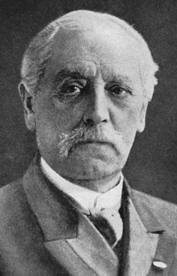Bing (company)
Bing was a German company founded in 1866 by the brothers Adolf Bing (1842–1915) and Ignaz Bing (1840–1918) as a wholesaler for household goods and toys in Nuremberg .
history
At first, the Bing brothers limited themselves to wholesale business before starting production in 1879. In 1885 the company already had 500 employees. Ten years later it was converted into a public company. There were numerous branches all over Germany and abroad . Before the First World War, Bing described itself as "the largest toy factory in the world". At that time the company had a total of over 4,000 employees. The factory building in Nuremberg, which has been preserved to this day, occupies a whole block between Stephan-, Vorderer Cramer-, Burger- and Kupferstraße and is an unmistakable landmark for rail travelers on the eastern approach to the main train station. Today it houses the Diehl headquarters.
During the First World War, the very export-oriented Bing company was badly affected by the trade restrictions. That is why the sales company Concentra was founded in 1917 to prepare future sales abroad. For the Concentra, a modern office building was built in the trade fair city of Leipzig from 1919 to 1920 by the architect Otto Droge .
Ignaz Bing died in 1918, his son Stephan Bing continued to run the company until 1927. After the First World War the company was called Bing-Werke AG. In the 1920s , new business areas were added and the company was split up. In the course of the global economic crisis of 1929, there were significant financing bottlenecks. In 1932 toy production finally had to be stopped in order to save other parts of the company. In the same year there was a compulsory settlement and the sale of the Bing company. The Nuremberg toy manufacturers Karl Bub and Kraus acquired machines, tools and finished parts for the Bing Railway, which was sold from 1932 to 1937 as the Karl Bub Miniature Railway .
Other parts of the Bing works were acquired by Fritz Hintermayr, who had saddles, tool bags for motorcycles and gas boilers manufactured in the Bing works from 1932 to 1945. BING carburetors have been manufactured there since 1937 . The Fritz Hintermayr GmbH Bing carburetor factory was renamed Bing Power Systems GmbH in 2001 .
The brand name Bing was revived in 2010 by the model car manufacturer Brekina for 1:43 scale models.
Products
Sheet metal and lacquered goods
The name Factory for household and kitchen appliances, toys, enamelled goods, bath stoves, ice boxes, typewriters describes the fields of activity of the company. The focus of production was on household goods made from enamelled sheet metal (saucepans, bowls). During the First World War the military were supplied with field harness, helmets and knapsacks.
Toy dolls
The company made a wide range of toys, including dolls. The popular models from Käthe Kruse were quite openly copied and also sold under the name Imitation of the Käthe Kruse dolls . Käthe Kruse did not want to accept that, however, she sued and won the case in 1925.
Tin toys and toy trains
The tin toys included the 1, 0 and 00 railways . Bing had a large market share for the large I and 0 gauges for a long time and was one of the leading German manufacturers alongside Märklin until production ended on August 24, 1932 .
The company produced large editions of model railways for export, especially as commissioned production for the English company Bassett-Lowke.
The Bing table train with a gauge of 16.0 mm came out in 1922 and was produced under this name until 1932. It can be seen as the direct forerunner of the TRIX EXPRESS model railway from 1935. This is no coincidence, after all, the owner and designer Stephan Bing switched from Bing to Trix in 1932 and brought his ideas there to develop a model railway that was ultra-modern for the time. The gauge designation 00 (later H0) was not used for the TRIX EXPRESS railway until 1935.
Combination of cinematograph and magic lantern , 1912
Two steam-powered road rollers from Bing from around 1920 in front of a steam engine with a standing brass boiler from Schönner
museum
Today you can see the tin toys of the Bing brothers in the Bing Museum in Freinsheim .
literature
- Toni Eckert: Ignaz Bing. in: Jewish life in Franconian Switzerland. Series of publications by the Franconian Switzerland Association. Volume 11. Erlangen / Jena 1997, pp. 738-747
- Rudolf Endres: The Bing family , in: Manfred Treml , Wolf Weigand (Hrsg.): History and culture of the Jews in Bavaria. Resumes . Munich: Saur, 1988, pp. 173-178
- Claude Jeanmaire: Bing in: The model railways of our grandfathers, archive no.17 second part Verlag Eisenbahn / Schweiz 1972, ISBN 3 85649 017 5
- Udo Becher: When the trains learned to drive, From the childhood days of the model railway publishing house Berlin, Transpress 1980, 2nd edition
- Udo Becher: On small traces, The beginnings of the model railway publishing house Berlin, Transpress 1970, 2nd edition
- Reinhard Schiffmann: Collectors Catalog, Volume 5, Bing Verlag Reinhard Schiffmann, Forchheim 1996, 6th edition
Web links
- Rudolf Endres: Bing Brothers, Nuremberg . In: Historical Lexicon of Bavaria
- Freinsheim Toy Museum: 1st Bing Museum - opening 2010 : Bing Museum
- Over time: Logos and logos : Bing logo
- Company stories / Bing at zinnfiguren-bleifiguren.com
Individual evidence
- ^ Rudolf Endres: Gebrüder Bing, Nuremberg , in: Historisches Lexikon Bayerns
Coordinates: 49 ° 26 '49.3 " N , 11 ° 6' 7.4" E






